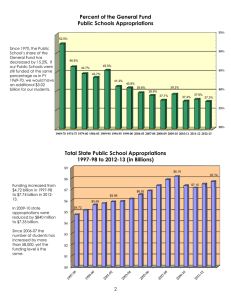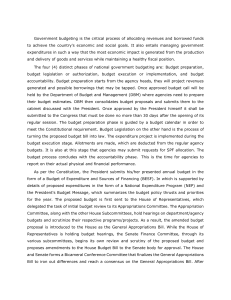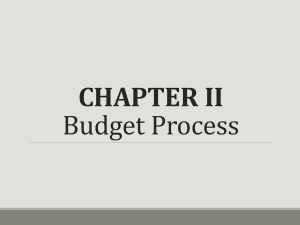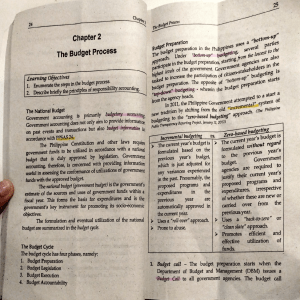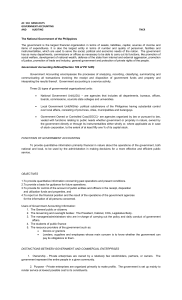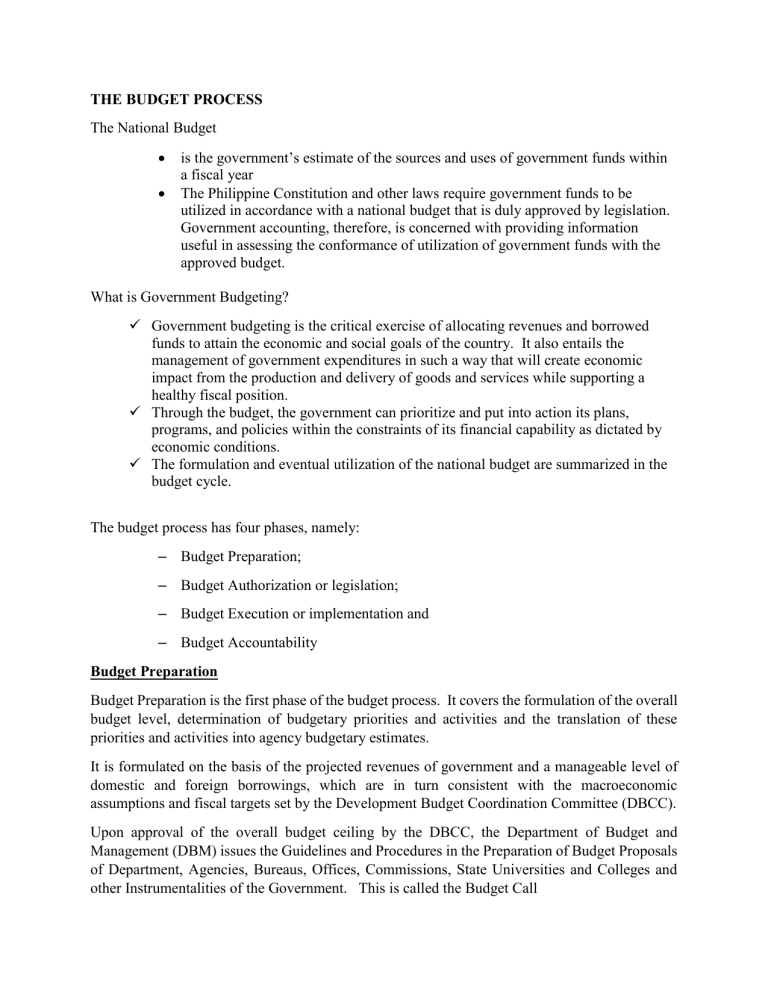
THE BUDGET PROCESS The National Budget is the government’s estimate of the sources and uses of government funds within a fiscal year The Philippine Constitution and other laws require government funds to be utilized in accordance with a national budget that is duly approved by legislation. Government accounting, therefore, is concerned with providing information useful in assessing the conformance of utilization of government funds with the approved budget. What is Government Budgeting? Government budgeting is the critical exercise of allocating revenues and borrowed funds to attain the economic and social goals of the country. It also entails the management of government expenditures in such a way that will create economic impact from the production and delivery of goods and services while supporting a healthy fiscal position. Through the budget, the government can prioritize and put into action its plans, programs, and policies within the constraints of its financial capability as dictated by economic conditions. The formulation and eventual utilization of the national budget are summarized in the budget cycle. The budget process has four phases, namely: – Budget Preparation; – Budget Authorization or legislation; – Budget Execution or implementation and – Budget Accountability Budget Preparation Budget Preparation is the first phase of the budget process. It covers the formulation of the overall budget level, determination of budgetary priorities and activities and the translation of these priorities and activities into agency budgetary estimates. It is formulated on the basis of the projected revenues of government and a manageable level of domestic and foreign borrowings, which are in turn consistent with the macroeconomic assumptions and fiscal targets set by the Development Budget Coordination Committee (DBCC). Upon approval of the overall budget ceiling by the DBCC, the Department of Budget and Management (DBM) issues the Guidelines and Procedures in the Preparation of Budget Proposals of Department, Agencies, Bureaus, Offices, Commissions, State Universities and Colleges and other Instrumentalities of the Government. This is called the Budget Call Budget Call contains, among other things, the next fiscal year’s targets, the agency’s budget ceiling and other guidelines in the completion and submission of agency budget proposals. After the issuance of the Budget Call, the DBM conducts a Budget Forum with the National Government Agencies to explain and elaborate on the contents of the Budget Call, entertain questions, and clarify issues raised by the National Government Agencies. This is to ensure proper compliance by the NGAs and facilitate the evaluation of proposals. Budget Forum/Hearings Conducted after the agencies submit their budget proposals. Each agency defends its budget proposal before the DBM. The DBM Deliberates on the budget proposal, makes recommendations, and consolidates the deliberated proposals into the National Expenditure Program (NEP) and Budget Expenditure and Sources of Financing (BESF). The DBM then submits the proposed budget to the President. What is the National Expenditure Program (NEP) The NEP is the budget document submitted by the President to the Congress. It presents the President’s Budget Proposal by Department/Agency and by Special Purpose Funds. What is Budget of Expenditures and Sources of Financing (BESF) Contains the estimated expenditures accompanied by estimates of expected sources of financing. After confirmation of the approved budget by the respective Department/Agency Heads, the NEP is finalized, submitted to the President for approval, and the President submits the NEP, together with the other budget documents, to Congress and Senate, within the time frames set in the Constitutions, i. e. within 30 days from the opening of the regular session. Budget Legislation/Authorization Phase This is the second phase of the budget process. It involved the review of the proposed National Expenditure Program (NEP) and enactment into law by the Legislature. In its review, the Congress is guided by the provision of law that it cannot increase the budget submitted by the Executive Department The NEP is the basis of the General Appropriations Bill (GAB) and eventually, the General Appropriations Act (GAA). • House of Representatives conducts hearings and prepares the General Appropriation Bill (GAB) • Senate conducts its own committee hearings and plenary deliberations on the General Appropriation Bill (GAB). • To harmonize any conflicts between the Representatives and Senate, a committee called Bicameral Conference Committee conduct Bicameral Conference then submit back to both Houses for ratification. After ratification, the final GAB is submitted to the President for approval of the GAA. The Budget Legislation ends when the President signs the General Appropriations Act (GAA) into law. Prior to this, the President may veto or set conditions for implementation for certain items in the GAA, which are contained in the President’s Veto Message. In the event where the President did not approved the GAA, a reenacted budget will be implemented. Approved Budget Is the expenditure authority derived from appropriation laws, government ordinances and other decisions related to the anticipated revenue or receipts for the budgetary period. The approved budget consists of the following: New General Appropriations Continuing Appropriations Supplemental Appropriations Automatic Appropriations Unprogrammed Funds Retained Income/Funds Revolving Funds Trust Receipts UACS Code 01 02 03 04 05 06 07 08 The Unified Accounts Code Structure (UACS) refers to the standard coding system used in financial reporting of the National Government. Appropriations - is the authorization made by a legislative body to allocate funds for purposes specified by the legislative or similar authority. New General Appropriations - are annual authorizations for incurring obligations during a specified budget year, as listed in the GAA. Continuing Appropriations- are the authorizations to support obligations for a specific purpose or project, such as multi-year construction projects which require the incurrence of obligations even beyond the budget year Supplemental Appropriations- are additional appropriations authorized by law to augment the original appropriations which proved to be insufficient for their intended purpose due to economic, political or social conditions supported by a Certification of Availability of Funds (CAF) from the BTr. Automatic Appropriations- are the authorizations programmed annually or for some other period prescribed by law, by virtue of outstanding legislation which does not require periodic action by Congress Unprogrammed Funds – standby appropriations authorized by Congress in the annual GAA which may be availed only when any of the following instances occur: a. Revenue collections exceed original revenue targets in the BESF submitted by the President to the Congress b. New revenues are collected or realized from sources not originally considered in the BESF c. Newly approved loan for foreign-assisted projects are secured or when conditions are triggered for other sources of funds such as perfected loan agreements for foreign assisted projects. Retained Income/Funds-collections which are authorized by law to be used directly by agencies concerned for their operation or specific purposes. Revolving Funds – receipts derived from business-type activities of departments/agencies which are authorized by law to be constituted as such and deposited in an authorized government depository bank. These funds shall be self-liquidating, and all obligations and expenditures incurred by virtue of said business type activity shall be charged against said fund. Trust Receipts – receipts by any government agency acting as trustee, agent, or administrator for the fulfilment if some obligations or conditions. Budget Execution Phase The third phase of the Budget Process. This is where the people’s money is actually spent. As soon as the GAA is enacted, the government can implement its priority programs, projects and activities. The budget execution phase begins with DBM’s issuance of guidelines on the release and utilization of funds. Agencies are required to submit their Budget Execution Documents (BEDs) at the start of budget execution. These documents outline agency plans and performance target. These BEDs includes the following: Physical and Financial Plan Monthly Cash Program Estimate of Monthly Income List of Obligations that are not yet due and demandable Major Recipients of the Budget National Government Agencies (NGAs) Local Government Units (LGUs) Government Owned and Controlled Corporation (GOCCs) The DBM formulates the Allotment Release Program(ARP) to set the limit for allotment release during the upcoming year. This is used as a control device to ensure that releases conform to the national budget. Alongside, is a Cash Release Program, which set the disbursement limits for the year, for each quarter and for each month. Allotment • is an authorization issued by the DBM to NGAs to incur obligations for specified amounts contained in a legislative appropriation in the form of budget release documents. It is also referred to as Obligational Authority. Obligation • is an act of a duly authorized official which binds the government to the immediate or eventual payment of a sum of money. Obligation maybe referred to as a commitment that encompasses possible future liabilities based on current contractual agreement. The following are the documents which authorize the entity to incur obligations: • General Appropriations Act Release Document (GAARD) – serves as the obligational authority for the comprehensive release of budgetary items appropriated in the GAA, categorized as For Comprehensive Release (FCR). • Special Allotment Release Order (SARO) – covers budgetary items under For Later Release (FLR) (negative list) in the entity submitted Budget Execution Documents (BEDs), subject to compliance of required documents/clearances. Releases of allotments for Special Purpose Funds (SPFs) (e.g., Calamity Fund, Contingent Fund, E-Government Fund, Feasibility Studies Fund, International Commitments Fund, Miscellaneous Personnel Benefits Fund and Pension and Gratuity Fund) are also covered by SAROs. • General Allotment Release Order (GARO) – is a comprehensive authority issued to all national government agencies, in general, to incur obligations not exceeding an authorized amount during a specified period for the purpose indicated therein. It covers automatically appropriated expenditures common to most, if not all, agencies without need of special clearance or approval from competent authority, i.e. Retirement and Life Insurance Premium. Incurrence of Obligation Government agencies incur obligations which will be paid by the government. Ex. Entering into contracts, hiring of personnel, purchase of supplies, etc Disbursement This is the final step of the budget execution phase, where government money are actually spent. The following documents authorize the entity to pay obligations and payables: Notice of Cash Allocation (NCA) – authority issued by the DBM to central, regional and provincial offices and operating units to cover the cash requirements of the agencies; Non-Cash Availment Authority (NCAA) – authority issued by the DBM to agencies to cover the liquidation of their actual obligations incurred against available allotments for availment of proceeds from loans/grants through supplier’s credit/constructive cash; Cash Disbursement Ceiling (CDC) – authority issued by DBM to the Department of Foreign Affairs (DFA) and Department of Labor and Employment (DOLE) to utilize their income collected/retained by their Foreign Service Posts (FSPs) to cover their operating requirements, but not to exceed the released allotment to the said post; and Notice of Transfer of Allocation – authority issued by the Central Office to its regional and operating units to cover the latter’s cash requirements. The budget process, of course, does not end when the government agencies spend public funds: each and every peso must be accounted for to ensure that is used properly, contributing to the achievement of socio-economic goals. Budget Accountability The fourth phase of budget process. This phase happens alongside the Budget Execution phase. Through Budget Accountability, the DBM monitors the efficiency of fund utilization, assess agency performance, and provides a vital basis for reforms and new policies Budget Accountability Reports (BARs) • This is submitted by agencies on a monthly and quarterly basis, BARs are required reports that show how agencies used their funds and identify their corresponding physical accomplishment. These include quarterly physical and financial reports of operations; quarterly income reports, a monthly statement of allotment, obligations and balances; and monthly report of disbursements. Performance Review - The DBM and COA perform periodic reviews of the agencies’ performance and budget accountability and report to the President. AUDIT- The COA audits the agencies The following budget reports/documents as required by DBM and COA shall be submitted: Quarterly Physical Report of Operation (QPRO) – Budget Accountability Report (BAR) No. 1 (Appendix 16) Statement of Appropriations, Allotments, Obligations, Disbursements and Balances – Financial Accountability Report (FAR) No. 1 (SAAODB) (Appendix 17) Summary of Appropriations, Allotments, Obligations, Disbursements and Balances by Object of Expenditures – FAR No. 1.A (SAAODBOE) (Appendix 18) List of Allotments and Sub-Allotments – FAR No. 1.B (Appendix 19) Statement of Approved Budget, Utilizations, Disbursements and Balances – FAR No. 2 (Appendix 20) Summary of Approved Budget, Utilizations, Disbursements and Balances by Object of Expenditures – FAR No. 2.A (Appendix 21) Aging of Due and Demandable Obligations – FAR No. 3 (Appendix 22) Monthly Report of Disbursements – FAR No. 4 (Appendix 23) Quarterly Report of Revenue and Other Receipts – FAR No. 5 (Appendix 24) These 4 Phases of the Budget Cycle overlap in continuing cycles every year. For instance while the Executive implements the budget for the current year, it also prepares the budget for the next fiscal year or defends it before the Congress. Meanwhile, the Execution and Accountability Phases are implemented simultaneously year round. To better evaluate the budget accountability of an entity, government accounting adheres to concept of responsibility accounting. Responsibility Accounting • provides access to cost and revenue information under the supervision of a manager having a direct responsibility for its performance. It is a system that measures the plans (by budgets) and actions (by actual results) of each responsibility center. Responsibility accounting aims to a) ensure that all costs and revenues are properly charged/credited to the correct responsibility center so that deviations from the budget can be readily attributed to managers accountable therefor; b) provide a basis for making decisions for future operations; and c) facilitate review activities, monitoring the performance of each responsibility center and evaluation of the effectiveness of agency’s operations Responsibility Center Code Structure • Each NGA shall be assigned a responsibility center code defined as organization code in the UACS Manual. For monitoring revenue and expenses, additional three-digit codes for the agency’s major offices/departments shall be appended to the organization code. The organization code and the agency’s major offices/departments’ code shall consist of 15 digits as follows:
